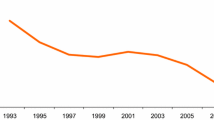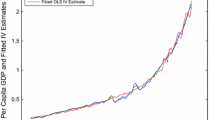Abstract
This paper analyses the international inequalities in \(\hbox {CO}_{2}\) emissions intensity for the period 1971–2009 and assesses explanatory factors. Group, additive and multiplicative methodologies of inequality decomposition are employed. The first allows us to understand the role of regional groups; the second allows us to investigate the role of different fossil energy sources (coal, oil and gas); and the third allows us to clarify the separated role of the carbonisation index and the energy intensity in the pattern observed for inequalities in \(\hbox {CO}_{2}\) intensities. The results show that, first, the reduction in global emissions intensity has coincided with a significant reduction in international inequality. Second, the bulk of this inequality and its reduction are attributed to differences between the groups of countries considered. Third, coal is the main energy source explaining these inequalities, although the growth in the relative contribution of gas is also remarkable. Fourth, the bulk of inequalities between countries and its decline are explained by differences in energy intensities, although there are significant differences in the patterns demonstrated by different groups of countries. The policy implications of these results are discussed.


Similar content being viewed by others
Notes
They identify various groups of countries that converge to different equilibriums and conclude that these differences are more due for differences in convergence in the carbonisation index than for differences in the dynamics of energy intensity.
The Theil (1) index can be decomposed, but the interaction element does not have a clear interpretation.
In short, as regards global IEA (2011) data, the analysis only excluded Botswana, Cambodia, Eritrea, Mongolia, Namibia and Netherlands Antilles, due to problems with the availability of data.
The estimates are based on Gaussian kernel functions (see Quah 1996) that have also, for example, been used in Ezcurra (2007) and Padilla and Serrano (2006) for the case of \(\hbox {CO}_{2}\) emissions per capita. The smoothing parameter is determined endogenously through the Silverman method (1986). The results did not vary significantly using other functions. Estimates are available upon request.
It must be kept in mind that coal is the most carbon intensive fossil source, whereas gas is the least. If we had two countries with same GDP, the one with higher coal in its energy mix would register, ceteris paribus, a higher \(\hbox {CO}_{2}\) intensity.
In terms of the absolute increase in emissions associated with coal, China is clearly the leading country, with an increase of 5,042 Mt between 1971 and 2009 (a 744 % increase); the increases are much lower in India with 938 Mt (658 % more) and the USA with 753 Mt (a 70 % increase). Among the countries with a greater reduction are Germany (264 Mt), the UK (235 Mt) and the former USSR (207 Mt). The increase in oil as a source of \(\hbox {CO}_{2}\) can be attributed to China (833 Mt), India (344 Mt) and Saudi Arabia (267 Mt), while the main reductions take place in the former USSR (220 Mt) and Germany (115 Mt). With respect to gas, the increase is especially attributable to the former USSR (693 Mt), which has abundant reserves of this resource.
In a study for OECD countries, Duro et al. (2010) showed for a similar period a significant trend towards the convergence of energy efficiency between countries sector by sector, which explained much of the general trend for decreasing differences in energy intensities, but also that sector specialisation was increasingly explaining inequality in the final use of energy. However, these results may not be extendable to our wider and more heterogeneous sample, which includes both developed and developing countries.
More sophisticated indicators have recently been used for analysing the convergence in “eco-efficiency”, such as the ones by Camarero et al. (2013a) for different greenhouse gases in 22 OECD countries, and Camarero et al. (2014) for different atmospheric pollutants, including \(\hbox {CO}_{2}\), in the EU. These studies assess “eco-efficiency” at both country and greenhouse-gas-specific levels using data envelopment analysis techniques and directional distance functions, and find an improvement in “eco-efficiency” and the existence of different clubs of convergence.
References
Aldy JE (2006) Per capita carbon dioxide emissions: convergence or divergence? Environ Resour Econ 33:533–555
Barassi MR, Cole MA, Elliott RJR (2011) The stochastic convergence of \(\text{ CO }_{2}\) emissions: a long memory approach. Environ Resour Econ 49:367–385
Bourguignon F (1979) Decomposable income inequality measures. Econometrica 47:901–920
Camarero M, Castillo J, Picazo-Tadeo AJ, Tamarit C (2013a) Eco-efficiency and convergence in OECD countries. Environ Resour Econ 55:87–106
Camarero M, Picazo-Tadeo AJ, Tamarit C (2013b) Are the determinants of \(\text{ CO }_{2}\) emissions converging among OECD countries? Econ Lett 118:159–162
Camarero M, Castillo-Giménez J, Picazo-Tadeo AJ, Tamarit C (2014) Is eco-efficiency in greenhouse gas emissions converging among European Union countries? Empir Econ 47(1):143–168
Cantore N, Padilla E (2010) Equality and \(\text{ CO }_{2}\) emissions distribution in climate change integrated assessment modelling. Energy 35(1):298–313
Cowell F (1995) Measuring inequality. Harvester Wheatsheaf, London
Duro JA (2012) On the automatic application of inequality indexes in the analysis of the international distribution of environmental indicators. Ecol Econ 76:1–7
Duro JA, Padilla E (2006) International inequalities in per capita \(\text{ CO }_{2}\) emissions: a decomposition methodology by Kaya factors. Energy Econ 28:170–187
Duro JA, Padilla E (2008) Analysis of the international distribution of per capita \({\mathit{CO}}_2\) emissions using the polarization concept. Energy Policy 36:456–466
Duro JA, Padilla E (2011) Inequality across countries in energy intensities: an analysis of the role of energy transformation and final energy transformation. Energy Econ 33:474–479
Duro JA, Padilla E (2013) Cross-country polarisation in \(\text{ CO }_{2}\) emissions per capita in the European Union: changes and explanatory factors. Environ Resour Econ 54(4):571–591
Duro JA, Padilla E, Alcántara V (2010) International inequality in energy intensity levels and the role of production composition and energy efficiency: an analysis of OECD countries. Ecol Econ 69(12):2468–2474
Ellerman AD, Wing IS (2003) Absolute vs. intensity-based emission caps. MIT Joint Program on the Science and Policy of Global Change, Report No. 100
Ezcurra R (2007) Is there cross-country convergence in carbon dioxide emissions? Energy Policy 35:1363–1372
Goerlich FJ (1998) Desigualdad, diversidad y convergencia: (algunos) instrumentos de medida. Instituto Valenciano de Investigaciones Económicas, S.A., Valencia
Groot L (2010) Carbon Lorenz curves. Resour Energy Econ 32(1):45–64
Hedenus F, Azar C (2005) Estimates of trends in global income and resource inequalities. Ecol Econ 55(3):351–364
Heil MT, Wodon QT (1997) Inequality in \(\text{ CO }_{2}\) emissions between poor and rich countries. J Environ Dev 6:426–452
Heil MT, Wodon QT (2000) Future inequality in \(\text{ CO }_{2}\) emissions and the impact of abatement proposals. Environ Resour Econ 17:163–181
International Energy Agency (IEA) (2011) \(\text{ CO }_{2}\) Emissions from fuel combustion—highlights, 2011th edn. OECD/IEA, Paris
Jobert T, Karanfil F, Tykhonenko A (2010) Convergence of per capita carbon dioxide emissions in the EU: legend or reality? Energy Econ 32:1364–1373
Millimet DL, Slottje D (2002) An environmental Paglin-Gini. Appl Econ Lett 9(4):271–274
Padilla E, Duro JA (2013) Explanatory factors of \(\text{ CO }_{2}\) per capita emission inequality in the European Union. Energy Policy 62(C):1320–1328
Padilla E, Serrano A (2006) Inequality in \(\text{ CO }_{2}\) emissions across countries and its relationship with income inequality: a distributive approach. Energy Policy 34:1762–1772
Quah D (1996) Convergence empirics across economics with (some) capital mobility. J Econ Growth 1:95–124
Romero-Ávila D (2008) Convergence in carbon dioxide emissions among industrialized countries revisited. Energy Econ 30:2265–2282
Shorrocks AF (1982) Inequality decomposition by factor components. Econometrica 50:193–211l
Shorrocks AF (1984) Inequality decomposition by population subgroups. Econometrica 52:1369–1386
Silverman BW (1986) Density estimation for statistics and data analysis, monographs on statistics and applied probability. Chapman and Hall, London
Strazicich MC, List JA (2003) Are \(\text{ CO }_{2}\) emission levels converging among industrial countries? Environ Resour Econ 24:263–271
Teixidó-Figueras J, Duro JA (2014) International ecological footprint inequality: a methodological review and some results. Environ Resour Econ . doi: 10.1007/s10640-014-9784-x
Theil H (1967) Economics and information theory. North Holland, Amsterdam
Acknowledgments
We are grateful to two anonymous reviewers and the editor. The authors acknowledge support from projects ECO2013-45380-P and ECO2012-34591 (Spanish Ministry of Economy and Competitiveness), and XREAP (DGR).
Author information
Authors and Affiliations
Corresponding author
Appendix
Appendix
1.1 Groups of countries:
-
OECD-Europe: Austria, Belgium, Czech Republic, Denmark, Finland, France, Germany, Greece, Hungary, Iceland, Ireland, Italy, Luxembourg, Netherlands, Norway, Poland, Portugal, Slovak Republic, Spain, Sweden, Switzerland, Turkey, United Kingdom.
-
OECD-North America: Canada, Mexico, United States.
-
OECD-Pacific: Australia, Japan, Korea, New Zealand.
-
Non-OECD Europe countries: Albania, Bulgaria, Cyprus, Gibraltar, Malta, Romania, Former USSR, Former Yugoslavia.
-
Africa: Algeria, Angola, Benin, Cameroon, Congo, Democratic Republic of Congo, Côte d’Ivoire, Egypt, Ethiopia, Gabon, Ghana, Kenya, Libya, Morocco, Mozambique, Nigeria, Senegal, South Africa, Sudan, United Republic of Tanzania, Togo, Tunisia, Zambia, Zimbabwe, Other Africa.
-
Latin America: Argentina, Bolivia, Brazil, Chile, Colombia, Costa Rica, Cuba, Dominican Republic, Ecuador, El Salvador, Guatemala, Haiti, Honduras, Jamaica, Nicaragua, Panama, Paraguay, Peru, Trinidad and Tobago, Uruguay, Venezuela, Other Latin America.
-
Middle East: Bahrain, Islamic Republic of Iran, Iraq, Israel, Jordan, Kuwait, Lebanon, Oman, Qatar, Saudi Arabia, Syria, United Arab Emirates, Yemen.
-
Asia: Bangladesh, Brunei Darussalam, Chinese Taipei, India, Indonesia, Dem. People’s Rep. of Korea, Malaysia, Myanmar, Nepal, Pakistan, Philippines, Singapore, Sri Lanka, Thailand, Vietnam, Other Asia.
-
China: People’s Republic of China, Hong Kong.
Rights and permissions
About this article
Cite this article
Duro, J.A., Teixidó-Figueras, J. & Padilla, E. Empirics of the International Inequality in \(\hbox {CO}_{2}\) Emissions Intensity: Explanatory Factors According to Complementary Decomposition Methodologies. Environ Resource Econ 63, 57–77 (2016). https://doi.org/10.1007/s10640-014-9840-6
Accepted:
Published:
Issue Date:
DOI: https://doi.org/10.1007/s10640-014-9840-6
Keywords
- \(\hbox {CO}_{2}\) international distribution
- Inequality decomposition
- \(\hbox {CO}_{2}\) emissions intensity




